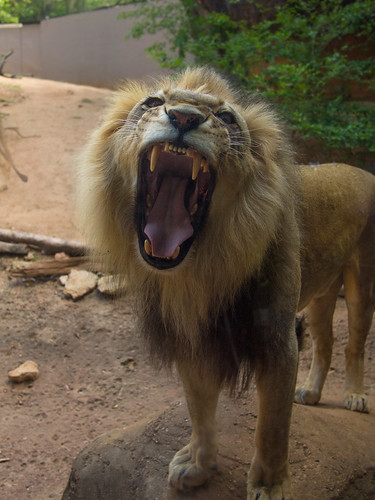An intimate view of the incisors of a young (sub-Saharan) male African lion. Despite appearances, the big cat was merely yawning. Any closer approach was impeded by reinforced acrylic.
At Zoo Atlanta, Atlanta (Grant Park), Georgia, on 13 April 2018.
**************
Endangered species protection endangered
In 2015, the U.S. Fish and Wildlife Service placed the African lion (Panthera leo) under the protection of the U.S. Endangered Species Act.The nearly extinct lions of western and central Africa—a subspecies now called P. l. leo—will be listed as endangered. Only about 1,400 of these lions remain scattered across more than a dozen countries, including the critically endangered Asiatic lions of India (the cats on the two continents were not previously considered the same subspecies). Another lion subspecies—P. p. melanochaita of east and southern Africa—will be listed as threatened. There are about 17,000 to 19,000 lions left in this subspecies, most of which live in protected but restricted habitats.— Scientific American.
That turns out ohave been fortuitous timing for African lions. Earlier this month, Donald Trump's Department of the Interior indicated its intention to eliminate all future protections for threatened species, effectively gutting the 1973 Endangered Species Act.
Under section 4(d) of the Endangered Species Act, the FWS created regulations in 1978 which granted threatened species, or those approaching endangerment, the same blanket protections granted to endangered species. Broadly, these regulations prevent “take” of protected species—death, harm, or harassment from human activity, such as hunting, capturing, and, in some cases, destroying their habitat through development, logging, or other means. “If you’re a threatened species and you don’t have ‘take’ protections, you don’t really have any protections at all,” Noah Greenwald, the endangered species director at the Center for Biological Diversity, tells Mother Jones. The change could be disastrous for species like the North American wolverine, the gopher tortoise, and the Sierra Nevada red fox, which are proposed for listing, or are being considered for, threatened status in the future.— Mother Jones.
-----more-----
- Pic(k) of the Week: one in a weekly series of photos taken (or noted) by me, posted on Saturdays, and often, but not always (as is the case today), with a good fermentable as the subject.
- See the photo on Flickr: here.
- Camera: Olympus Pen E-PL1.
- Settings: 20mm | ISO 200 | 1/320 | f/2.8
- Commercial reproduction requires explicit permission, as per Creative Commons.
- For more from YFGF:
- Follow on Twitter: @Cizauskas.
- Like on Facebook: YoursForGoodFermentables.
- Follow on Flickr: Cizauskas.
- Follow on Instagram: @tcizauskas.












No comments:
Post a Comment
Comment here ...